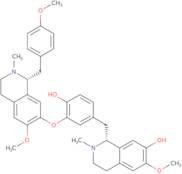Isoliensinine
CAS: 6817-41-0
Ref. 3D-FI73832
| 2mg | Discontinued | ||
| 5mg | Discontinued | ||
| 10mg | Discontinued | ||
| 25mg | Discontinued | ||
| 50mg | Discontinued |
Product Information
- (1R)-1,2,3,4-Tetrahydro-1-[[4-hydroxy-3-[[(1R)-1,2,3,4-tetrahydro-6-methoxy-1-[(4-methoxyphenyl)methyl]-2-methyl-7-isoquinolinyl]oxy]phenyl]methyl]-6-methoxy-2-methyl-7-isoquinolinol
- 7-Isoquinolinol, 1,2,3,4-tetrahydro-1-[[4-hydroxy-3-[[1,2,3,4-tetrahydro-6-methoxy-1-[(4-methoxyphenyl)methyl]-2-methyl-7-isoquinolinyl]oxy]phenyl]methyl]-6-methoxy-2-methyl-, [R-(R*,R*)]-
- 7-isoquinolinol, 1,2,3,4-tetrahydro-1-[[4-hydroxy-3-[[(1R)-1,2,3,4-tetrahydro-6-methoxy-1-[(4-methoxyphenyl)methyl]-2-methyl-7-isoquinolinyl]oxy]phenyl]methyl]-6-methoxy-2-methyl-, (1R)-
- Isoliensinin
Isoliensinine is a natural compound that belongs to the class of bisbenzylisoquinoline alkaloids. It is structurally related to morphine and is an enzyme substrate for several polymerases, including mitochondrial DNA polymerase. Isoliensinine has been shown to inhibit the growth of cells in culture by inducing apoptosis. Isoliensinine binds to the surface of cells, which induces the release of chemoattractant protein from the cell surface and leads to increased migration of immune cells into inflamed tissues. Isoliensinine also dephosphorylates cysteine residues on proteins, leading to changes in mitochondrial membrane potential and cellular death.





